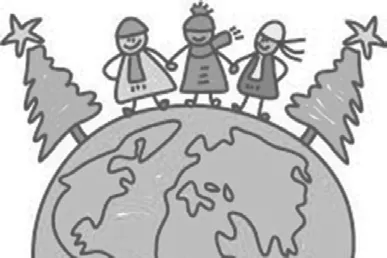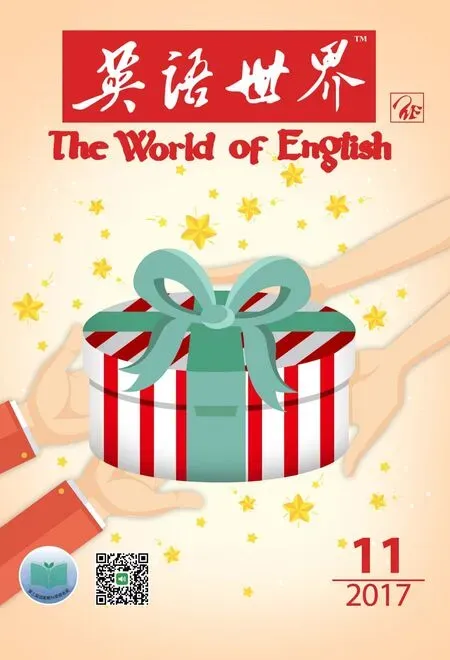世界上独特的赠礼传统
2018-01-06孙巧
译/孙巧
世界上独特的赠礼传统
译/孙巧
Unique Gift Giving Traditions from Around the World

无论是为了某个特别的节日,还是为了表达感谢,抑或是为了让对方明白你很在乎,赠送礼物都是人类共同的习俗。各地赠礼的目的也许相近,但赠礼的传统却因国而异。在某地表示尊重的赠礼行为,在另一个地方看来则可能会被视为无礼。一起看看世界各地独一无二的赠礼传统吧。
Whether for a special holiday, as a token of gratitude or just a way of letting someone know you care, giftgiving is a universal custom. Though the intent may be similar from place to place, traditions vary widely from one country to the next. A gesture that conveys respect in one place might be considered offensive somewhere else. Take a look at our list of unique gifting traditions from around the world.
在欧洲,别不小心与人一刀两断。
在美国,一套厨房刀具似乎是十分理想的婚礼或节日礼物。然而在某些欧洲国家,如德国,迷信让人们相信赠送刀具会割断朋友之间的友谊。打破这种迷信的办法是:在刀或礼品盒上绑一枚硬币。收礼人把硬币还给赠礼之人以示“付款”,用以抵消厄运。
In Europe, don’t accidentally cut yourself out of someone’s life.
Here in the U.S., a set of kitchen knives seems like the perfect gift idea for a wedding or holiday. However, in certain European countries like Germany, superstition dictates that a knife presented as a gift will sever your friendship. There is a way to beat this superstition: Tie a penny to the knife or gift box. The receiver then returns the penny to you as a “payment” to nullify1nullify抵消。the bad luck.
在英国,60周年结婚纪念日礼物是钻石。
在英国,彩票的购买、交换比世界上任何地方都要多,而且适合作为生日礼物。原本钻石在英国象征75年婚姻生活,但由于维多利亚女王登基60年便举办了钻禧庆典,因而现在钻石代表60周年纪念。
In Britain, diamonds are 60th wedding anniversary gifts.
Lottery tickets are bought and exchanged here more than they are anywhere else in the world, and often make a suitable birthday gift. Though diamonds originally symbolised 75 years of married life in the UK2一般来说,金婚为结婚50周年,银婚为结婚25周年,钻石婚为结婚60周年,也有些国家将结婚40周年称为银婚,75周年称为钻石婚。, they are now associated with 60, as Victoria’s 60 years on the throne marked her Jubilee3=Diamond Jubilee钻禧,通常是指个人事件的60周年纪念(如结婚纪念、君主登基纪念)或集体事件的75周年纪念(如大学校庆)。传统上,个人的钻禧纪念也是75周年,但自英国维多利亚女王登基钻禧纪念后,这一传统发生了改变。自1861年维多利亚女王的丈夫阿尔伯特亲王去世后她便基本从公众视野中消失,从而引发了国民的不安。因此后来决定将她的登基钻禧提前至1897年6月22日60周年时举行,以打消民众的疑虑。而2012年6月2日举行的伊丽莎白二世登基钻禧纪念是英国历史上第二次君主登基钻禧纪念。.
参加意大利婚礼,给自己买片领带。
意大利婚礼上有名的传统就是把新郎的领带切成许多小片。婚礼来宾通过“购买”这些领带片,交换现金给新人。这种有趣的方式让宾客得到婚礼纪念品,又给新郎新娘随了礼金。
意大利的小朋友除了受到圣诞老人的眷顾外,在1月6日主显节结束时,还会收到巫女装进他们袜子里的礼物。有趣的是,公司之间或公司内部不会互赠礼物,因为人们认为这种行为有点俗气。
At an Italian wedding, buy yourself a piece of the tie.
There’s a well-known Italian wedding tradition where the groom’s tie is cut into a number of tiny pieces. Wedding guests can then “buy” these tie slices in exchange for cash. It’s a fun way to give money to the bride and groom that leaves guests with a wedding souvenir.
In addition to a visit from Santa, Italian kids have their stockings fi lled by a fallacious witch at the end of Epiphany4主显节,1月6日纪念贤士朝拜耶稣。on January 6. Interestingly, gifts are not exchanged between or within companies, as the act is deemed a little tacky.
在俄罗斯,伏特加酒并不是称心的礼物。
受苏联时期统治方式影响,与圣诞节相比俄罗斯人更乐于庆祝新年。也许伏特加看起来是最适合俄罗斯人的礼物,可实际上在很多俄罗斯人看来这是没创意的礼物。许多人甚至会认为送伏特加酒这一想法就是无礼的。
In Russia, Vodka is not a desirable gift.
Due to the way Russia was governed during the Soviet era, Russians celebrate New Year with more gusto than they do at Christmas. While Vodka might seem the most suitable gift for a Russian, a lot of them would see it as an unimaginative gesture. Many even perceive the notion as insulting.
在以色列,没人送礼物,也没人收礼物。
尽管有送礼物这种善意的举动,但感谢卡和感谢便条在以色列赠礼传统中并不常见。与美国犹太人在光明节互换礼物不同,来自以色列或在以色列居住的犹太人通常不会互换礼物。
In Israel, nobody’s giving or receiving gifts.
Despite the kind gesture, thank you cards and notes are not a common part of the gifting custom in Israel. Contrary to the way American Jews exchange gifts during Hanukkah5光明节,历时八天的犹太人节日,纪念公元前165年重修耶路撒冷圣殿。, those from or residing in Israel won’t typically receive gifts from one another.
在印第安人中,主人赠送礼物,而不是接收礼物。
印第安人的赠礼礼节与任何其他文化都相反。按照传统,在婚礼和预祝仪式上(生日不算在内),其他文化中是主人接收礼物,而印第安文化中则为来宾接收礼物。
In Native America, your host gives gifts rather than receive them.
Native American gifting etiquette is exactly the opposite to that of any other culture. Traditionally during weddings and powwow6powwow预祝典礼(出发打猎、打仗前的跳舞、狂欢)。celebrations (birthdays aren’t always recognised), guests are the receivers of gifts rather than whomever the host may be.
在日本,赠礼方式至关重要。
日本人非常重视赠礼(因收到感谢礼物而又赠出感谢礼物也不足为奇),而赠礼方式直接影响礼物的接收。举例来说,赠送无包装的现金会令人不快。那么,无论用作礼物还是支付小费的现金都要装进信封,保证收礼物的人受到尊重。
按照惯例,人们会在新婚礼物的信封上打个装饰死结,因为民间传说新婚礼物的信封应该“打不开”。
In Japan, presentation is paramount.
The Japanese place a great emphasis on the act of gift giving (it’s not unheard of to send a thank-you gift for a thank-you gift), and presentation7presentation赠送仪式,献礼。plays a big role in determining how your gift is received. For example, it’s considered distasteful to hand off uncovered cash. So whether you’re sending money as a gift or just leaving a tip, place your money in an envelope to ensure it’s received in a respectful manner.
It’s also customary to place a tight decorative knot on a wedding gift envelope, since folklore dictates that the envelope should be “impossible to open.”
在中国,红包和双数会带来好运。
中国新年有一整套丰富的传统。节日里最流行的习俗就是赠送装在红色信封里的钱,这叫作“压岁钱”,是“用来镇恶驱邪的钱”,是要带来好运的。
除了送钱的方式,对礼金的金额也有迷信。单数金额跟“白金”(葬礼上的礼金)相联系,被视为厄运。哪怕是礼金的第一位数都一定要保证是双数,像30和50都被视为单数。
In China, red envelopes and even denominations bring good luck.
Chinese New Year has a rich set of traditions. One of the most popular customs of this holiday is giving out money in red envelopes. Known as “yasuiqian” which means “the money used to suppress the evil spirit,” these gifts are meant to bring good luck.
In addition to how you give money, there’s also superstition around the amount you give. Gifting an odd numbered amount of money is associated with the “baijin,”gifts given during funerals, and is considered bad luck. It’s important to make sure that even the fi rst digit is even, as numbers like 30 and 50 are considered odd.
在印度,用右手送礼物。
印度文化认为左手不干净,像接触、传递钱物或赠送礼物都要用右手。与某些文化不同,印度文化视单数的物件或钱为吉利。例如,11镑比10镑好。
In India, gifts are given with the right hand.
As left hands are considered unclean in Indian culture, gestures such as touching, passing money, or giving gifts are to be done with the right hand. Contrary to some other cultures, an odd number of objects or currency denotes good luck. For example, £11 should be given as opposed to £10.
在南美,锋利的物件不吉利。
南美洲国家的大部分人认为赠送锋利尖锐的物件是想断绝关系的标志,所以送礼物最好避免赠送剪刀和厨刀。圣诞节节期最后一天1月6日前夕,阿根廷的孩子们通常会把鞋留在床边,等着装满小礼物。在巴西,海边的居民会把鲜花、水果或珠宝撒向大海以祭水神。
In South America, sharp objects are unlucky.
The majority of people from South American countries will see the offering of sharp objects as a sign that you want the relationship with them severed, so scissors and cooking knives are best avoided. On the eve of January 6 at the end of the Christmas period, Argentinian children will customarily leave their shoes by their beds to be filled with small gifts. Meanwhile in Brazil, seaside settlements will send gifts of fl owers, fruits or jewellery out to sea to honour the Goddess of Water.
在特立尼达和多巴哥,年龄再小都能收礼物。
在特立尼达和多巴哥,人们习惯把钱放在新生儿手里来庆祝孩子的出生。这种做法表达了对孩子健康茁壮成长的美好祝愿。
In Trinidad and Tobago, nobody’s too young for a gift.
In Trinidad & Tobago, it’s customary to celebrate the birth of a newborn baby by placing money in its hand. This gesture conveys best wishes for the child’s healthy and prosperous upbringing.
在津巴布韦,舞蹈胜过千言万语。
在津巴布韦,直接要礼物的情况并不少见。在没提要求而收到礼物的情况下,即使送礼方家庭极度贫困,拒绝接收也绝对是下下策。同时人们认为用动作表示感谢胜过口头答谢。表示感谢的动作可以是蹦蹦跳跳,也可以是翩翩起舞,或者吹个口哨。 □
In Zimbabwe, a dance can speak a thousand words.
In Zimbabwe, it is not uncommon to be directly asked for a gift. When one has been bought even without requesting it, the worst you can do is to refuse the offering, even if the family giving is starving. Also, gestures of thanks are preferred over verbal reciprocation. These may include jumping up and down, dancing, or whistling.
(译者曾获第五届“《英语世界》杯”翻译大赛优秀奖)
